Environmental Management: Population Impact and Ecological Report
VerifiedAdded on 2022/09/12
|5
|1083
|19
Report
AI Summary
This report analyzes the environmental management of Australia, focusing on the country's ecological footprint and the impact of its population. It begins with an introduction to Australia's land area and population, highlighting the concept of the ecological footprint as a measure of human demand on nature. The report examines the relationship between population growth, natural resource consumption (both renewable and non-renewable), and ecological surplus. It notes that Australia has a high ecological footprint per person, significantly exceeding that of less developed countries. The report also discusses the detrimental effects of ecological surplus on the environment and the economy, including the depletion of natural resources and the generation of carbon dioxide emissions. The study concludes that Australia's economic development and high population growth are key factors contributing to its ecological surplus and high ecological footprint, emphasizing the need for efficient resource consumption to mitigate environmental damage.
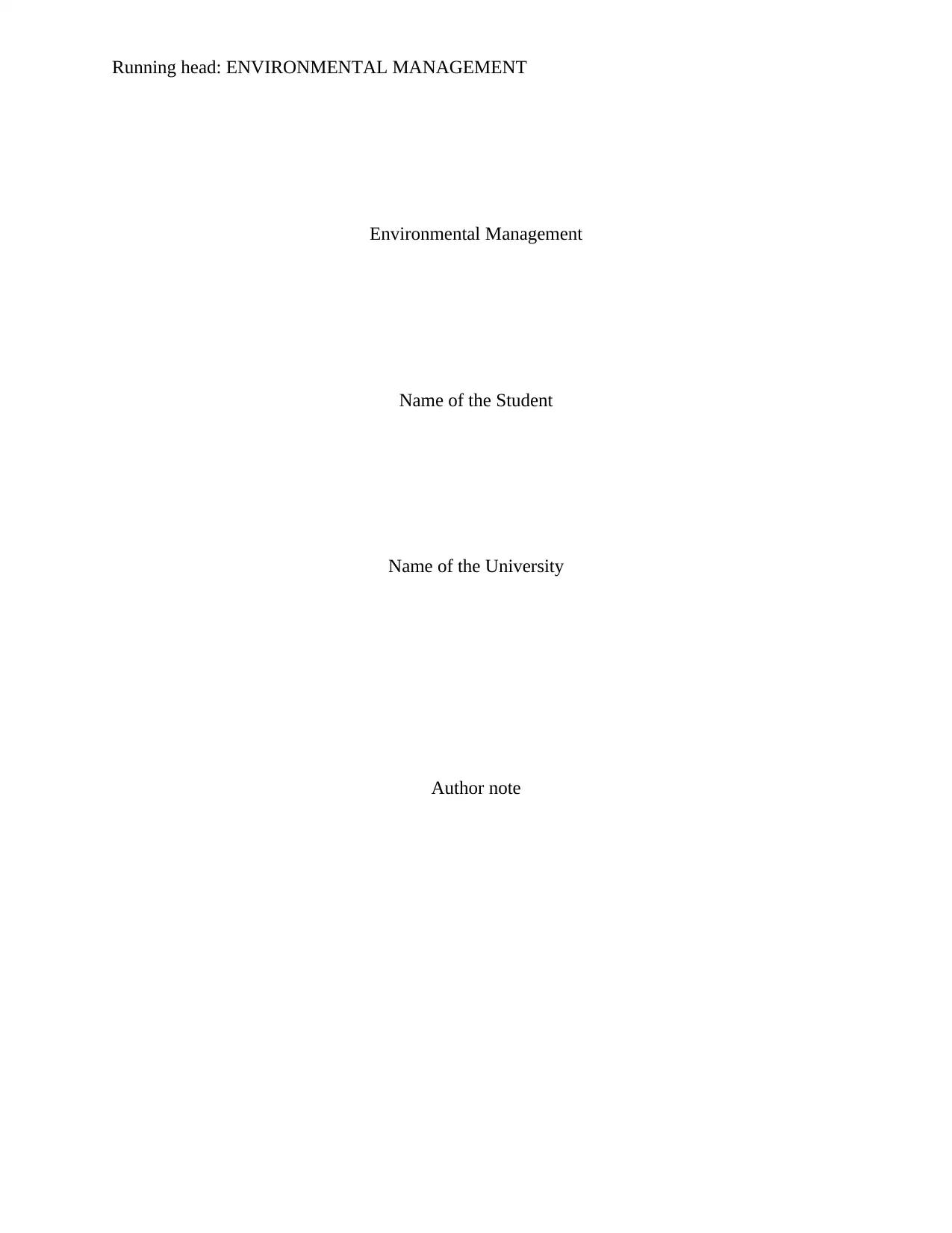
Running head: ENVIRONMENTAL MANAGEMENT
Environmental Management
Name of the Student
Name of the University
Author note
Environmental Management
Name of the Student
Name of the University
Author note
Paraphrase This Document
Need a fresh take? Get an instant paraphrase of this document with our AI Paraphraser
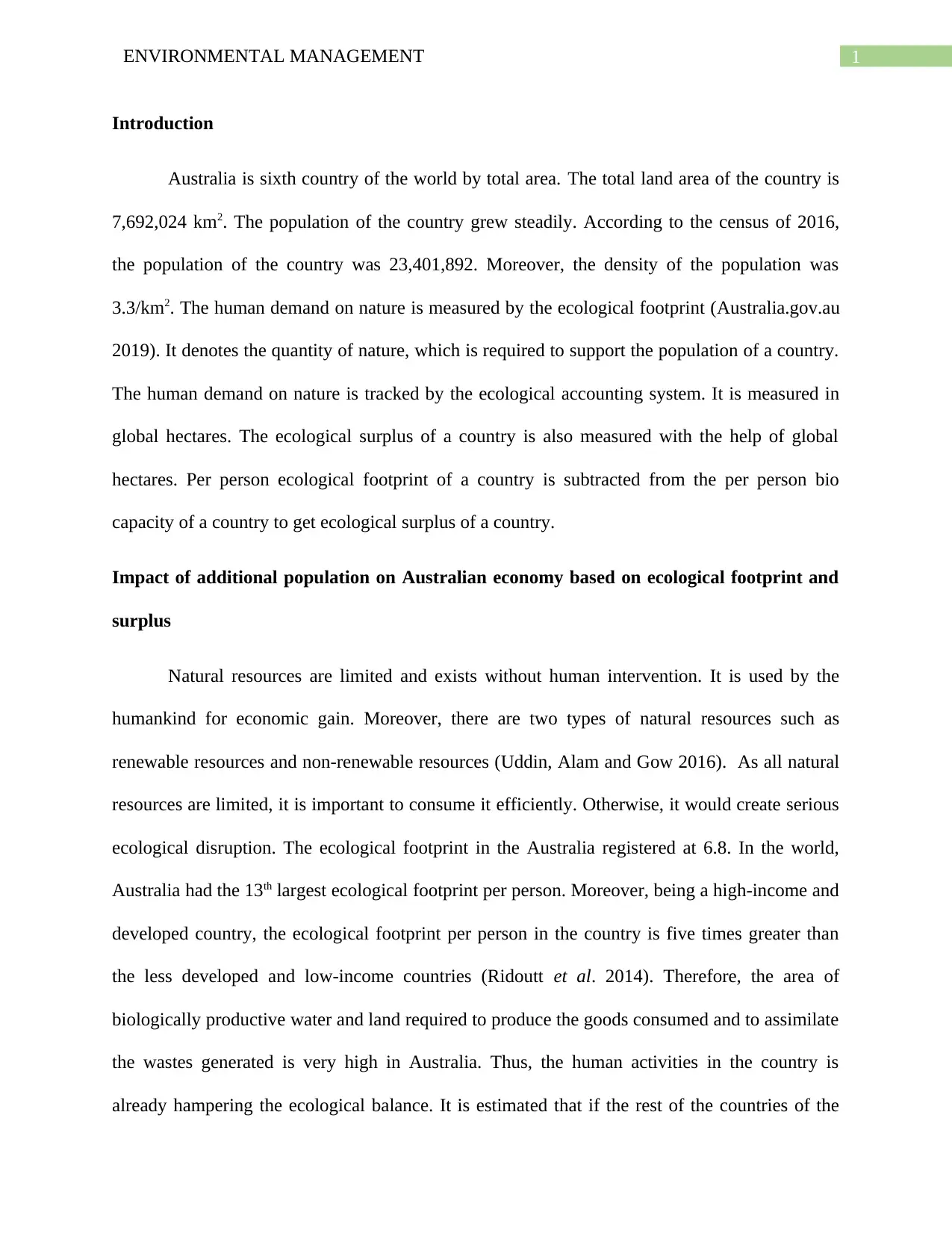
1ENVIRONMENTAL MANAGEMENT
Introduction
Australia is sixth country of the world by total area. The total land area of the country is
7,692,024 km2. The population of the country grew steadily. According to the census of 2016,
the population of the country was 23,401,892. Moreover, the density of the population was
3.3/km2. The human demand on nature is measured by the ecological footprint (Australia.gov.au
2019). It denotes the quantity of nature, which is required to support the population of a country.
The human demand on nature is tracked by the ecological accounting system. It is measured in
global hectares. The ecological surplus of a country is also measured with the help of global
hectares. Per person ecological footprint of a country is subtracted from the per person bio
capacity of a country to get ecological surplus of a country.
Impact of additional population on Australian economy based on ecological footprint and
surplus
Natural resources are limited and exists without human intervention. It is used by the
humankind for economic gain. Moreover, there are two types of natural resources such as
renewable resources and non-renewable resources (Uddin, Alam and Gow 2016). As all natural
resources are limited, it is important to consume it efficiently. Otherwise, it would create serious
ecological disruption. The ecological footprint in the Australia registered at 6.8. In the world,
Australia had the 13th largest ecological footprint per person. Moreover, being a high-income and
developed country, the ecological footprint per person in the country is five times greater than
the less developed and low-income countries (Ridoutt et al. 2014). Therefore, the area of
biologically productive water and land required to produce the goods consumed and to assimilate
the wastes generated is very high in Australia. Thus, the human activities in the country is
already hampering the ecological balance. It is estimated that if the rest of the countries of the
Introduction
Australia is sixth country of the world by total area. The total land area of the country is
7,692,024 km2. The population of the country grew steadily. According to the census of 2016,
the population of the country was 23,401,892. Moreover, the density of the population was
3.3/km2. The human demand on nature is measured by the ecological footprint (Australia.gov.au
2019). It denotes the quantity of nature, which is required to support the population of a country.
The human demand on nature is tracked by the ecological accounting system. It is measured in
global hectares. The ecological surplus of a country is also measured with the help of global
hectares. Per person ecological footprint of a country is subtracted from the per person bio
capacity of a country to get ecological surplus of a country.
Impact of additional population on Australian economy based on ecological footprint and
surplus
Natural resources are limited and exists without human intervention. It is used by the
humankind for economic gain. Moreover, there are two types of natural resources such as
renewable resources and non-renewable resources (Uddin, Alam and Gow 2016). As all natural
resources are limited, it is important to consume it efficiently. Otherwise, it would create serious
ecological disruption. The ecological footprint in the Australia registered at 6.8. In the world,
Australia had the 13th largest ecological footprint per person. Moreover, being a high-income and
developed country, the ecological footprint per person in the country is five times greater than
the less developed and low-income countries (Ridoutt et al. 2014). Therefore, the area of
biologically productive water and land required to produce the goods consumed and to assimilate
the wastes generated is very high in Australia. Thus, the human activities in the country is
already hampering the ecological balance. It is estimated that if the rest of the countries of the
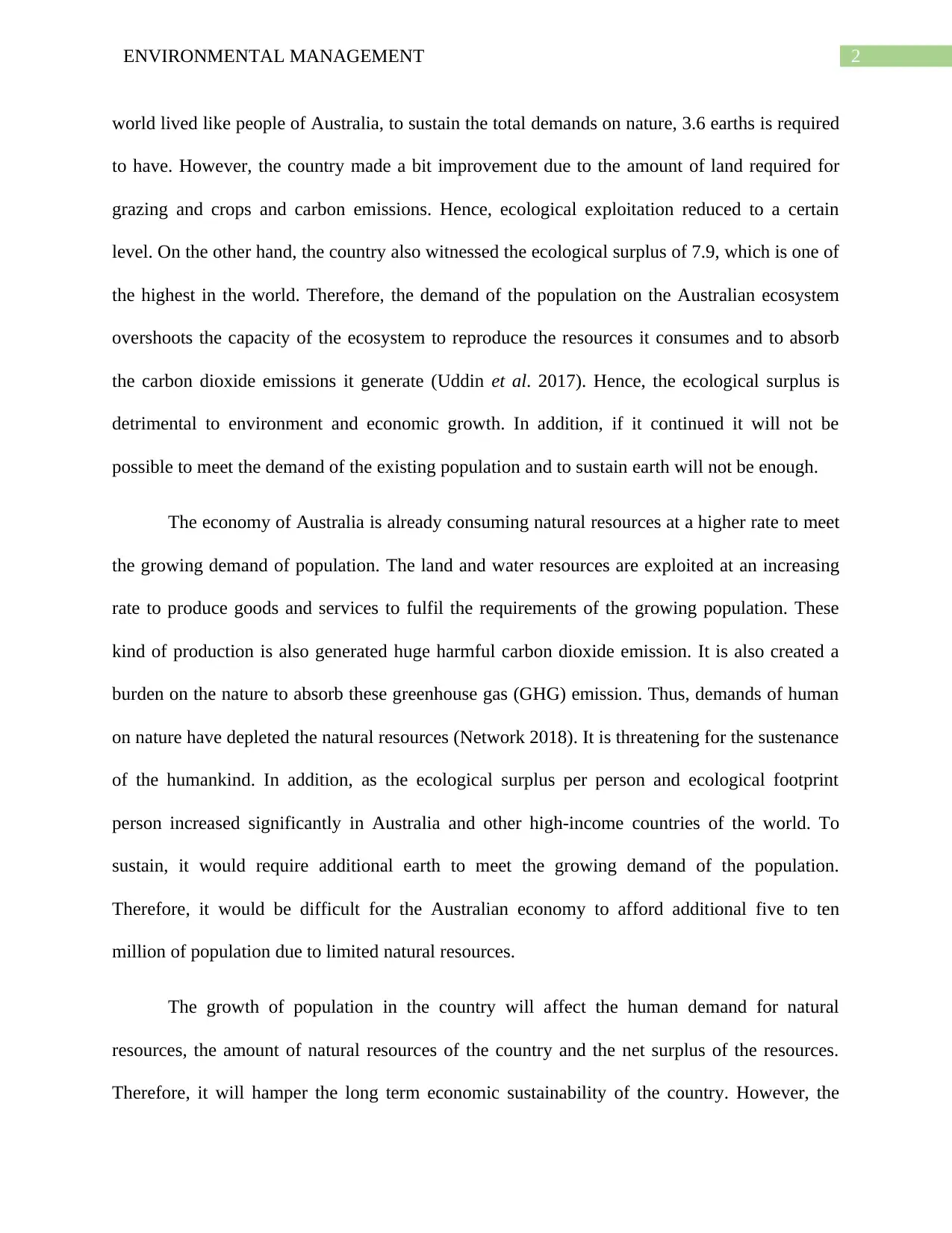
2ENVIRONMENTAL MANAGEMENT
world lived like people of Australia, to sustain the total demands on nature, 3.6 earths is required
to have. However, the country made a bit improvement due to the amount of land required for
grazing and crops and carbon emissions. Hence, ecological exploitation reduced to a certain
level. On the other hand, the country also witnessed the ecological surplus of 7.9, which is one of
the highest in the world. Therefore, the demand of the population on the Australian ecosystem
overshoots the capacity of the ecosystem to reproduce the resources it consumes and to absorb
the carbon dioxide emissions it generate (Uddin et al. 2017). Hence, the ecological surplus is
detrimental to environment and economic growth. In addition, if it continued it will not be
possible to meet the demand of the existing population and to sustain earth will not be enough.
The economy of Australia is already consuming natural resources at a higher rate to meet
the growing demand of population. The land and water resources are exploited at an increasing
rate to produce goods and services to fulfil the requirements of the growing population. These
kind of production is also generated huge harmful carbon dioxide emission. It is also created a
burden on the nature to absorb these greenhouse gas (GHG) emission. Thus, demands of human
on nature have depleted the natural resources (Network 2018). It is threatening for the sustenance
of the humankind. In addition, as the ecological surplus per person and ecological footprint
person increased significantly in Australia and other high-income countries of the world. To
sustain, it would require additional earth to meet the growing demand of the population.
Therefore, it would be difficult for the Australian economy to afford additional five to ten
million of population due to limited natural resources.
The growth of population in the country will affect the human demand for natural
resources, the amount of natural resources of the country and the net surplus of the resources.
Therefore, it will hamper the long term economic sustainability of the country. However, the
world lived like people of Australia, to sustain the total demands on nature, 3.6 earths is required
to have. However, the country made a bit improvement due to the amount of land required for
grazing and crops and carbon emissions. Hence, ecological exploitation reduced to a certain
level. On the other hand, the country also witnessed the ecological surplus of 7.9, which is one of
the highest in the world. Therefore, the demand of the population on the Australian ecosystem
overshoots the capacity of the ecosystem to reproduce the resources it consumes and to absorb
the carbon dioxide emissions it generate (Uddin et al. 2017). Hence, the ecological surplus is
detrimental to environment and economic growth. In addition, if it continued it will not be
possible to meet the demand of the existing population and to sustain earth will not be enough.
The economy of Australia is already consuming natural resources at a higher rate to meet
the growing demand of population. The land and water resources are exploited at an increasing
rate to produce goods and services to fulfil the requirements of the growing population. These
kind of production is also generated huge harmful carbon dioxide emission. It is also created a
burden on the nature to absorb these greenhouse gas (GHG) emission. Thus, demands of human
on nature have depleted the natural resources (Network 2018). It is threatening for the sustenance
of the humankind. In addition, as the ecological surplus per person and ecological footprint
person increased significantly in Australia and other high-income countries of the world. To
sustain, it would require additional earth to meet the growing demand of the population.
Therefore, it would be difficult for the Australian economy to afford additional five to ten
million of population due to limited natural resources.
The growth of population in the country will affect the human demand for natural
resources, the amount of natural resources of the country and the net surplus of the resources.
Therefore, it will hamper the long term economic sustainability of the country. However, the
⊘ This is a preview!⊘
Do you want full access?
Subscribe today to unlock all pages.

Trusted by 1+ million students worldwide
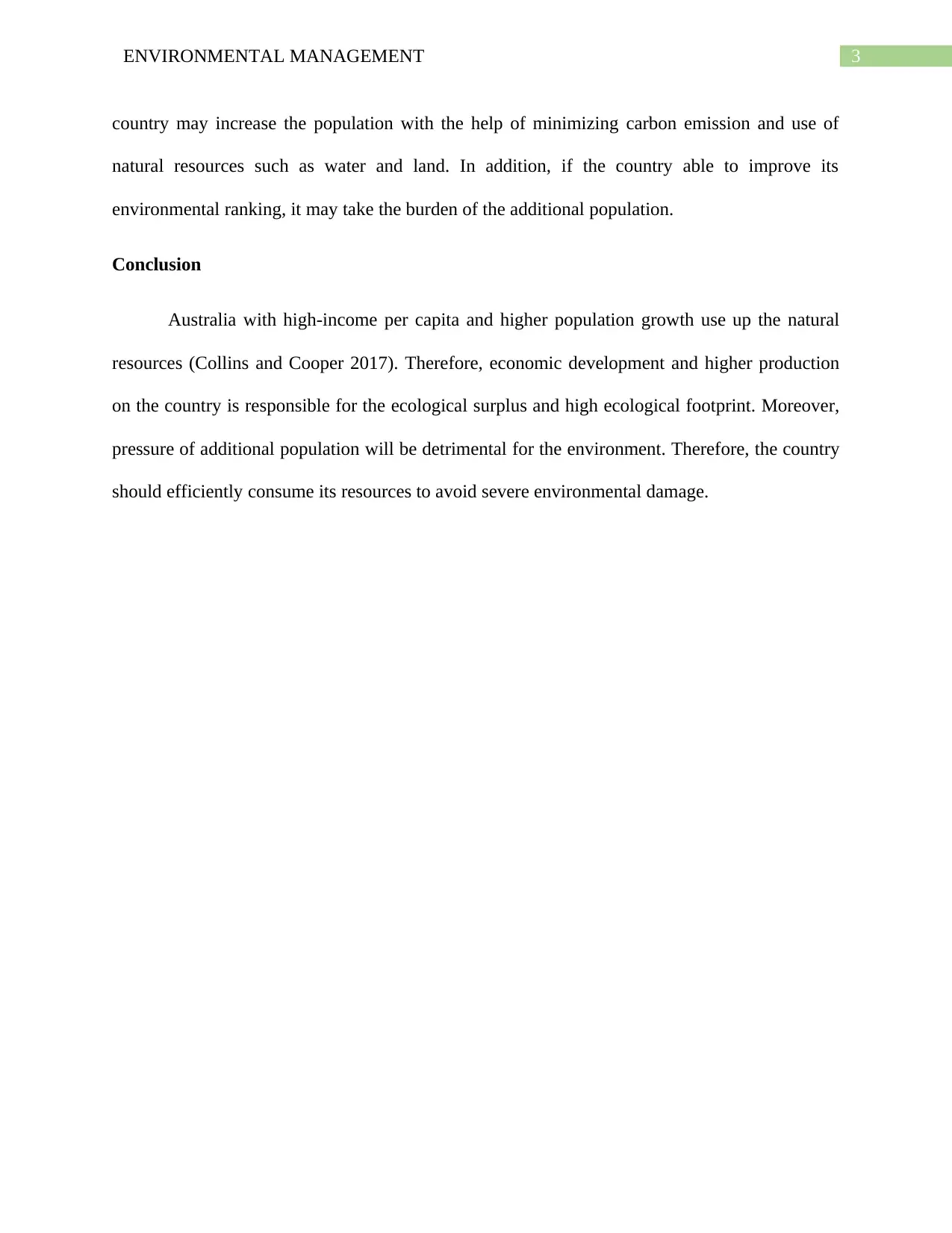
3ENVIRONMENTAL MANAGEMENT
country may increase the population with the help of minimizing carbon emission and use of
natural resources such as water and land. In addition, if the country able to improve its
environmental ranking, it may take the burden of the additional population.
Conclusion
Australia with high-income per capita and higher population growth use up the natural
resources (Collins and Cooper 2017). Therefore, economic development and higher production
on the country is responsible for the ecological surplus and high ecological footprint. Moreover,
pressure of additional population will be detrimental for the environment. Therefore, the country
should efficiently consume its resources to avoid severe environmental damage.
country may increase the population with the help of minimizing carbon emission and use of
natural resources such as water and land. In addition, if the country able to improve its
environmental ranking, it may take the burden of the additional population.
Conclusion
Australia with high-income per capita and higher population growth use up the natural
resources (Collins and Cooper 2017). Therefore, economic development and higher production
on the country is responsible for the ecological surplus and high ecological footprint. Moreover,
pressure of additional population will be detrimental for the environment. Therefore, the country
should efficiently consume its resources to avoid severe environmental damage.
Paraphrase This Document
Need a fresh take? Get an instant paraphrase of this document with our AI Paraphraser
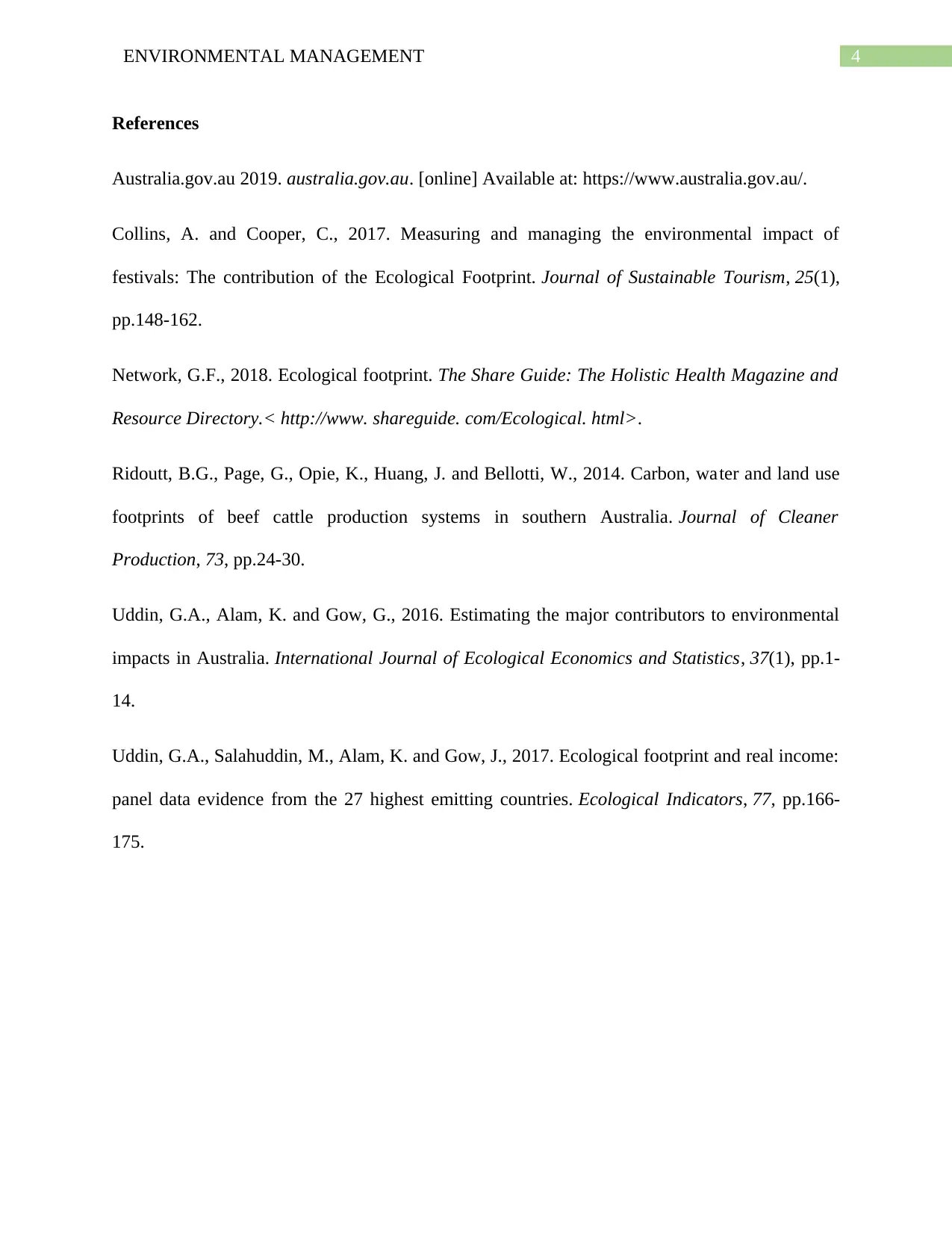
4ENVIRONMENTAL MANAGEMENT
References
Australia.gov.au 2019. australia.gov.au. [online] Available at: https://www.australia.gov.au/.
Collins, A. and Cooper, C., 2017. Measuring and managing the environmental impact of
festivals: The contribution of the Ecological Footprint. Journal of Sustainable Tourism, 25(1),
pp.148-162.
Network, G.F., 2018. Ecological footprint. The Share Guide: The Holistic Health Magazine and
Resource Directory.< http://www. shareguide. com/Ecological. html>.
Ridoutt, B.G., Page, G., Opie, K., Huang, J. and Bellotti, W., 2014. Carbon, water and land use
footprints of beef cattle production systems in southern Australia. Journal of Cleaner
Production, 73, pp.24-30.
Uddin, G.A., Alam, K. and Gow, G., 2016. Estimating the major contributors to environmental
impacts in Australia. International Journal of Ecological Economics and Statistics, 37(1), pp.1-
14.
Uddin, G.A., Salahuddin, M., Alam, K. and Gow, J., 2017. Ecological footprint and real income:
panel data evidence from the 27 highest emitting countries. Ecological Indicators, 77, pp.166-
175.
References
Australia.gov.au 2019. australia.gov.au. [online] Available at: https://www.australia.gov.au/.
Collins, A. and Cooper, C., 2017. Measuring and managing the environmental impact of
festivals: The contribution of the Ecological Footprint. Journal of Sustainable Tourism, 25(1),
pp.148-162.
Network, G.F., 2018. Ecological footprint. The Share Guide: The Holistic Health Magazine and
Resource Directory.< http://www. shareguide. com/Ecological. html>.
Ridoutt, B.G., Page, G., Opie, K., Huang, J. and Bellotti, W., 2014. Carbon, water and land use
footprints of beef cattle production systems in southern Australia. Journal of Cleaner
Production, 73, pp.24-30.
Uddin, G.A., Alam, K. and Gow, G., 2016. Estimating the major contributors to environmental
impacts in Australia. International Journal of Ecological Economics and Statistics, 37(1), pp.1-
14.
Uddin, G.A., Salahuddin, M., Alam, K. and Gow, J., 2017. Ecological footprint and real income:
panel data evidence from the 27 highest emitting countries. Ecological Indicators, 77, pp.166-
175.
1 out of 5
Related Documents
Your All-in-One AI-Powered Toolkit for Academic Success.
+13062052269
info@desklib.com
Available 24*7 on WhatsApp / Email
![[object Object]](/_next/static/media/star-bottom.7253800d.svg)
Unlock your academic potential
Copyright © 2020–2025 A2Z Services. All Rights Reserved. Developed and managed by ZUCOL.





